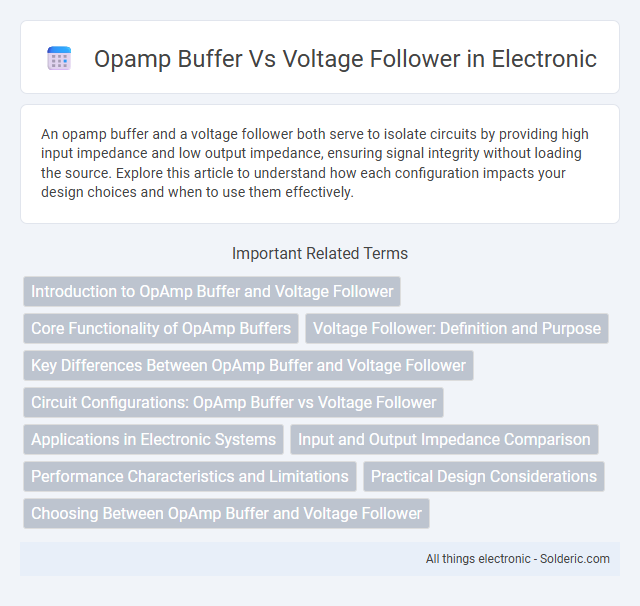An opamp buffer and a voltage follower both serve to isolate circuits by providing high input impedance and low output impedance, ensuring signal integrity without loading the source. Explore this article to understand how each configuration impacts your design choices and when to use them effectively.
Comparison Table
| Feature | Op-Amp Buffer | Voltage Follower |
|---|---|---|
| Description | Operational amplifier configured to provide unity gain buffer | Specific op-amp buffer with output tied directly to inverting input, gain = 1 |
| Gain | Unity (1) or adjustable | Always unity (1) |
| Input Impedance | Very high (typically > 1 MO) | Extremely high, near op-amp input impedance limits |
| Output Impedance | Low (typically < 100 O) | Low, suitable for driving loads |
| Purpose | Isolate, buffer signals with no gain | Impedance matching, prevent loading effects |
| Feedback Configuration | Negative feedback with output connected to inverting input | Output directly connected to inverting input |
| Signal Phase | No phase shift (0deg) | No phase shift (0deg) |
| Common Applications | Buffer input signals, prevent loading | Voltage buffering, isolation in sensor circuits |
Introduction to OpAmp Buffer and Voltage Follower
An opamp buffer, commonly known as a voltage follower, is an operational amplifier configuration with a unity gain that provides high input impedance and low output impedance. This setup isolates signal sources from loads, preventing signal degradation in circuits requiring impedance matching. Voltage followers are essential in analog signal processing for maintaining signal integrity while driving subsequent stages without voltage loss.
Core Functionality of OpAmp Buffers
OpAmp buffers and voltage followers both serve the core functionality of isolating circuit stages by providing high input impedance and low output impedance. They ensure your signal remains unchanged in voltage while delivering current drive capability to subsequent loads. This isolation prevents loading effects and maintains signal integrity across various electronic applications.
Voltage Follower: Definition and Purpose
A voltage follower, also known as an op-amp buffer, is an operational amplifier configuration where the output voltage directly follows the input voltage, providing a unity gain of 1. Its primary purpose is to isolate different circuit stages by offering high input impedance and low output impedance, preventing signal loading and preserving signal integrity. Your circuit benefits from improved stability and accurate voltage transfer without amplification or signal distortion.
Key Differences Between OpAmp Buffer and Voltage Follower
An op-amp buffer and a voltage follower both serve as unity gain amplifiers but differ in application and design nuances. An op-amp buffer primarily isolates circuits to prevent loading effects, offering high input impedance and low output impedance without amplification, while a voltage follower specifically emphasizes output voltage tracking input voltage precisely with minimal phase shift. The key difference lies in their typical usage: buffers enhance signal integrity in high-impedance sources, whereas voltage followers ensure stable voltage levels in feedback and sensor circuits.
Circuit Configurations: OpAmp Buffer vs Voltage Follower
An op amp buffer and a voltage follower share the same circuit configuration where the output is directly connected to the inverting input, creating unity gain. This configuration ensures the voltage follower provides high input impedance and low output impedance, ideal for impedance matching without amplification. Both terms are often used interchangeably to describe this simple feedback topology in operational amplifier applications.
Applications in Electronic Systems
Opamp buffers and voltage followers are essential components in electronic systems for impedance matching and signal isolation, ensuring accurate signal transfer without loading the source. Your circuit benefits from an opamp buffer when driving high-impedance loads or preventing signal distortion in sensitive measurement devices. Voltage followers, a specific type of opamp buffer, are widely used in sensor interfaces, audio electronics, and data acquisition systems to maintain signal integrity.
Input and Output Impedance Comparison
An opamp buffer and a voltage follower both provide high input impedance and low output impedance, minimizing signal loss between stages. The input impedance of an opamp buffer typically ranges from megaohms to gigaohms, ensuring minimal loading on the preceding circuit, while the output impedance is usually less than a few ohms, allowing it to drive low-impedance loads effectively. Voltage followers, as a specific type of opamp buffer, emphasize unity gain and maintain these impedance characteristics to preserve signal integrity in measurement and amplification applications.
Performance Characteristics and Limitations
An op amp buffer, often implemented as a voltage follower configuration, provides unity gain, high input impedance, and low output impedance, making it ideal for impedance matching and signal isolation. Performance characteristics include minimal voltage offset, fast slew rate, and low input bias current, which influence accuracy and speed in various applications. Limitations involve bandwidth constraints, finite gain-bandwidth product, and potential output distortion under heavy loads or high-frequency signals.
Practical Design Considerations
Opamp buffers and voltage followers both provide high input impedance and low output impedance, essential for signal integrity in analog circuits. Practical design considerations include offset voltage, bandwidth limitations, and power consumption, with voltage followers often preferred for simplicity and stability in low-frequency applications. You should evaluate the specific op amp's slew rate and input bias current to ensure the buffer maintains signal accuracy under your circuit's operating conditions.
Choosing Between OpAmp Buffer and Voltage Follower
When choosing between an op amp buffer and a voltage follower, consider that both configurations provide high input impedance and low output impedance, ideal for impedance matching and signal isolation. Your decision should depend on the specific application requirements; an op amp buffer typically refers to any unity-gain amplifier setup, while a voltage follower specifically denotes a unity-gain configuration providing a direct voltage output equal to the input. Understanding the subtle differences in terminology and circuit implementation helps optimize performance in analog signal processing tasks.
opamp buffer vs voltage follower Infographic

 solderic.com
solderic.com